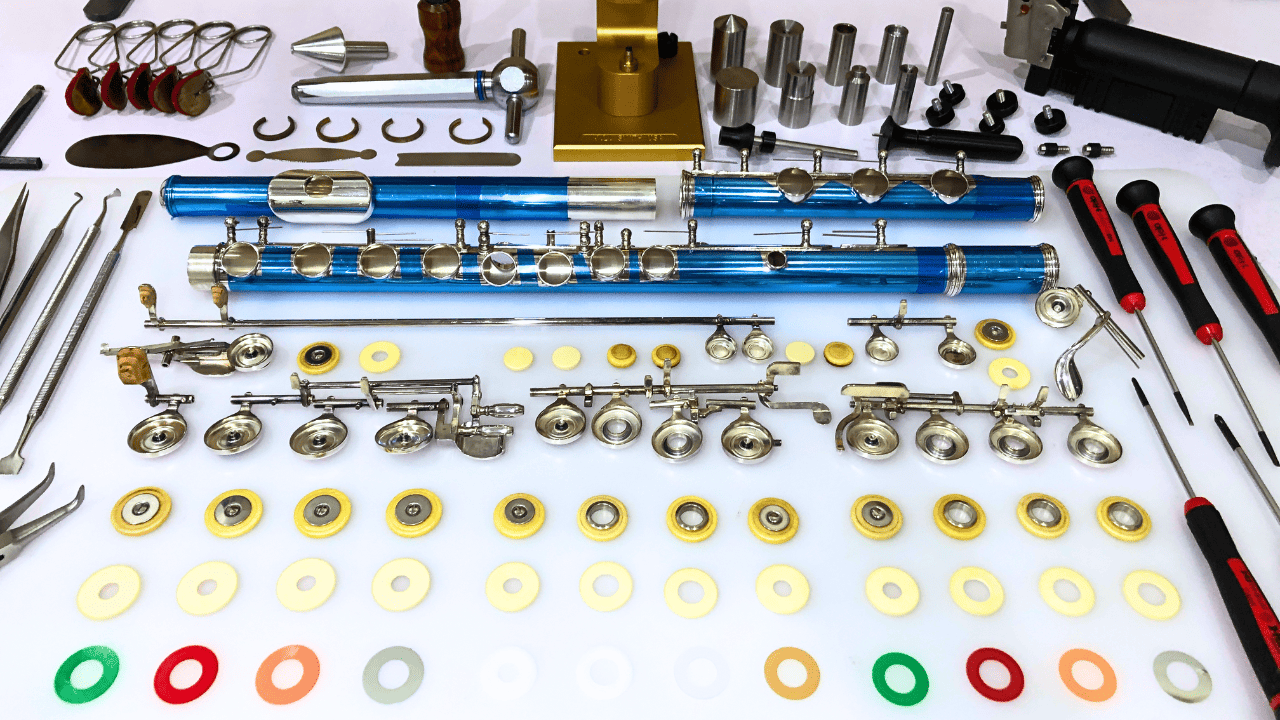Besides refining your skills as a performer, you may also want to make your flute more personal. Or maybe you want to become more recognizable to your audience. High-quality flute accessories are powerful supporting elements, which can enhance your performance, highlight your personality, and, what’s more, protect the instrument in everyday life. Let’s find out what accessories you can use for this purpose and why it matters to invest in them even if you’re a beginner.
Flute Crowns
1. Function: The flute crown is a small cap located at the end of the flute’s headjoint that is essential for proper tuning and resonance. This component maintains the position of the cork inside the headjoint, which directly affects the flute’s intonation and response.
2. Variety: Flute crowns typically feature a dome shape and various finishes ranging from brushed silver to luxurious gold options. Such premium materials like sterling silver or gold not only make these components durable but also enhance the tone color of the instrument. Together with silver and gold options, you can find flute crowns encrusted with stones, which work as an eye-catching decoration and unique gift ideas.

3. Why use: As a decorative element, a flute crown can contribute to the appearance of the instrument and your personal musician’s brand, helping you become more recognizable. Flute crowns made of gold featuring floral engraving or decorated with stones work perfectly for flutists playing in high-profile settings. Such embellishments can turn your instrument into a centerpiece in any performance. Customizing your flute with such crowns, you can create an absolutely different impression of the same flute model used by your fellow musicians.
However, flute crowns are not only about enhancing the visual appeal, as their materials and weights also affect your playing experience. There’s the opinion that the material of the flute crown helps focus the air column as it passes through the headjoint. This makes the articulation more precise and enhances projection. Heavier crowns, handcrafted of gold or adorned with stones, add a slightly darker feel to the tone, while lighter silver-plated crowns can make the sound brighter. Gold crowns are especially valued by flutists who play in orchestras as they provide a richer tone.
Flute Gig Bags
1. Function: The gig bag is what protects your delicate instrument from shocks, dents, accidental drops, and environmental changes during your everyday travel from home to music school or rehearsal spot.
2. Variety: Among options available on the market, you can find models offering various levels of protection, ranging from hard cases to soft bags. While a standard hard case provides basic protection for your flute, a high-quality bag goes a step further offering enhanced features, which may include:
-
soft and thick padding in the areas around the headjoint, body joint, and footjoint, protecting the most important and vulnerable mechanisms;
-
water-resistant exteriors, featuring genuine leather that protects the instrument from humidity and moisture;
-
sealed seams for extra protection against moisture to prevent any harm to working mechanisms;
-
a warming layer inside to protect the flute from extreme low or hot temperatures.
Premium-quality flute bags also range in colors, designs and styles. For instance, you can opt for modern-style flute bags serving as an alternative for hardshell cases. They don’t include any rough details, offering a spacious compartment for the instrument, a handle and a shoulder strap allowing for versatile carrying options. These bags work perfectly for musicians with an active lifestyle, students, and intermediate-level flutists.

Alternatively you can choose classic-style flute bags as those available on our website. They feature elongated shapes and offer a classy elegant design with a unique closure. Two leather straps with buckles contribute to the overall classic style, while offering enhanced hold of the flute without the risk of accidental falling out. These bags are appreciated by flutists who value both practical features and eye-catching appearance. Among classic-style models, you can even find bags featuring genuine leather and canvas that are perfectly tailored for the shape of the instrument.
When it comes to leather interiors, there are many to choose from:
-
Flotar leather, which captures attention with grains of irregular shape.
-
Detroit leather of smooth texture with natural imperfections and variations in grain.
-
Crazy Horse leather with its distressed and weathered look with vintage vibe, developing a rich patina over years.
3. Why use: Flute bags with their padded interiors, water-resistant materials, multiple pockets, and comfortable carrying options create a high-level protection that is important for flutists who travel frequently, attend lessons or rehearsals regularly, or perform in various climate conditions. In addition to functionality, flute bags function as elements of personal expression, becoming a real reflection of the flutist’s character. Leather bags not only stand for durability and resistance to wear, but also can be additionally personalized with embossed initials, symbols, or names.
Conclusion
Investing in high-quality flute accessories is not limited to just boosting the instrument’s design. Flute accessories also make your performance better and preserve the initial quality of your flute. For instance, accessories like flute crowns and flute bags influence both how your flute plays and how long it stays in excellent condition. You can experiment with crowns of different weight and design to improve projection and tone. Regarding bags, you can opt for classic-style or modern-style bags with warming layering, multiple pockets, and comfortable carrying options.

It’s never too early to experiment with flute accessories. If you feel like you want to add a more personal touch to your instrument, why not do it right now? Explore a full range of flute accessories on our website.
Would you like to learn more about flute finishes and how they affect performance? Recently we've explored How Flutes Made from Gold, Silver, or Platinum Differ in Sound.

